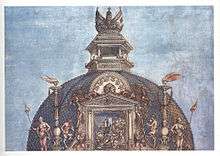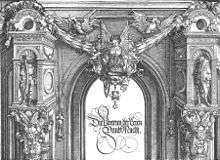Triumphal Arch (woodcut)
The Triumphal Arch (also known as the Arch of Maximilian I, German: Ehrenpforte Maximilians I.) is a 16th-century monumental woodcut print, commissioned by the Holy Roman Emperor Maximilian I. The composite image was printed on 36 large sheets of paper from 195 separate wood blocks. At 295 × 357 centimetres (116 × 141 in), it is one of the largest prints ever produced, and was intended to be pasted to walls in city halls or the palaces of princes.[1] It is part of a series of three huge prints created for Maximilian, the others being a Triumphal Procession (1516–18, 137 woodcut panels, 54 metres (177 ft) long) which is led by a Large Triumphal Carriage (1522, 8 woodcut panels, 8 × 1.5 feet (244 × 46 cm)); only the Arch was completed in Maximilian's lifetime and distributed as propaganda, as he intended. Together, this series has been described by art historian Hyatt Mayor as "Maximilian's program of paper grandeur". They stand alongside two published biographical allegories in verse, the Theuerdank and Weisskunig, heavily illustrated with woodcuts.
.jpg)

Very large multi-sheet prints designed to decorate walls were a feature of the early 16th century, although their use in this way means their survival rate is exceptionally low. The prints were intended to be hand-coloured, but only two sets of impressions from the first edition survive with contemporary colouring (held in Berlin and Prague).[2]
Design and execution
The architectural form of the arch was designed by Tyrolean architect and court painter Jörg Kölderer, and elaborated by Maximilian's court historian and mathematician Johannes Stabius, modelled on the triumphal arches constructed by Roman Emperors in Ancient Rome (although Maximilian's arch was never intended to be constructed in stone). It may have been inspired by a six-panel woodcut View of Venice, a bird's-eye view of Venice designed by Jacopo de' Barbari and published by the Nuremberg publisher Anton Kolb, both of whom entered the employ of Maximilian from about 1500. Detailed drawings for the woodcuts were created between 1512 and 1515, mainly by Albrecht Dürer and his pupils, Hans Springinklee and Wolf Traut; the flanking round towers are attributed to Albrecht Altdorfer.[1]
The design includes three arches: the central arch is entitled "Honour and Might", the left arch is "Praise", and the right arch is "Nobility". Each arch is illustrated with scenes relating to Maximilian, including a family tree above the central arch which leads back to Clovis I, first King of the Franks, and then the mythical Francia, Sicambria and Troia, flanked by heraldic escutcheons, and 12 historical scenes above each of the two side arches. To the left are busts of emperors and kings, including Julius Caesar and Alexander the Great, and to the right are Maximilian's ancestors. Towers to each side show scenes from Maximilian's private life. Towards the lower right is a line of three shields showing the coats of arms of Stabius, Kölderer and Dürer. Many panels contain a descriptive text, and a long inscription at the bottom describes the whole. The design includes elements of Egyptian hieroglyphs, influenced by Willibald Pirckheimer's 1514 translation of the Hieroglyphica by Roman author Horapollo.
Distribution

The print is dated 1515 on two blocks, indicating when the designs were completed (save for the 24th historical block – intended to show Maximilian's tomb – which remained blank). The wood blocks were cut from 1515 to 1517 by Hieronymus Andreae of Nuremberg, no doubt with workshop assistance. About 700 sets of impressions were printed in a first edition in 1517-18, and given by Maximilian as gifts, mostly to the cities and princes of the Holy Roman Empire. Examples of the first edition include those in the print rooms at the British Museum, the Albertina in Vienna, and museums in Berlin, Copenhagen, Prague, and elsewhere.
A second edition of about 300 was authorised by Archduke Ferdinand (Maximilian's grandson and later Holy Roman Emperor) in 1526–28, and a third edition by Archduke Charles (Ferdinand's son) in 1559. Separate editions of just the scenes from Maximilian's life were printed, the first in 1520 just after his death.[1] A separate print of the tomb, itself another major piece of Habsburg propagandizing, was created, to be pasted over the empty 24th historical panel. A fourth edition was published by Adam Bartsch in Vienna in 1799, with many of the block showing considerable wear - several missing blocks were replaced by etchings by Bartsch (including the Battle of Utrecht, Maximilian's coronation, and the First Congress of Vienna; the 24th panel shows a new image of the Battle of Pavia). A fifth edition followed in 1886.
171 of the 195 original wood blocks survive, and are held by the Albertina, Vienna.[3]
References
Notes
- Bartrum, (1995), 51
- Bartrum, (2002), 138
- Bartrum, (1995), 53
Bibliography
- Bartrum, Giulia, German Renaissance Prints, 1490–1550, British Museum Press, 1995, ISBN 0-7141-2604-7
- Bartrum, Giulia, Albrecht Dürer and his Legacy, British Museum Press, 2002, ISBN 0-7141-2633-0
- Kurth, Willi & C. Dodgson, The complete woodcuts of Albrecht Dürer, Courier Dover Publications, 1963, ISBN 0-486-21097-9
- The Triumphal Arch of Emperor Maxmilian I, Metropolitan Museum of Art
- Albrecht Dürer and others, The Triumphal Arch, woodcut from the British Museum
- Stiber, Linda S., Elmer Eusman & Sylvia Albro, "The Triumphal Arch and the Large Triumphal Carriage of Maximilian I: Two oversized, multi-block, 16th-century Woodcuts from the Studio of Albrecht Durer", The American Institute for Conservation, The Book and Paper Group Annual, Vol. 14, 1995
Further reading
- Grand Scale: Monumental Prints in the Age of Dürer and Titian: Monumental Prints in the Age of Durer and Titian, 2008, Larry Silver and Elizabeth Wyckoff
External links
| Wikimedia Commons has media related to Albrecht Dürer woodcut series - Triumphal Arch. |
- Dürer's paper triumph: the arch of the Emperor Maximilian, British Museum. Good zoomable images
- text in Russian but many images
- One night at the Museum: moving Dürer's paper triumph, Joanna Kosek, conservator, British Museum
- Restoring Albrecht Dürer's masterpiece The Arch of Honour of Maximilian I., National Gallery of Denmark
.jpg)